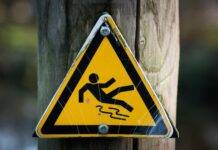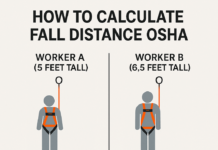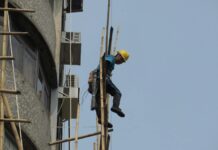
Fall Protection Plan Requirements: Safeguarding Workers at Heights
Introduction to Fall Protection Plan
A fall protection plan stands as a critical pillar in ensuring workplace safety, specifically when tasks involve working at heights. Whether in construction, maintenance, or various industrial settings, adhering to fall protection requirements isn’t just obligatory—it’s a moral responsibility towards workers’ well-being.
Understanding OSHA Standards
Importance of Compliance
The Occupational Safety and Health Administration (OSHA) mandates stringent regulations to prevent falls. Understanding and complying with these standards isn’t merely about avoiding penalties; it’s about safeguarding lives.
Key Components of OSHA Regulations
Within OSHA’s framework, certain fundamental components form the backbone of a robust fall protection plan. These include assessment, prevention, and mitigation strategies.
Creating a Comprehensive Fall Protection Plan
Assessing Risks and Hazards
Before anything else, a thorough assessment of potential risks and hazards is indispensable. Identifying these factors lays the groundwork for tailored preventative measures.
Selecting Appropriate Equipment
Equipping workers with the right tools is pivotal. From harnesses and guardrails to safety nets, each element contributes to a collective shield against falls.
Training and Education
Empowering workers through comprehensive training is non-negotiable. Educating them about hazards, proper equipment usage, and emergency procedures is paramount for their safety.
Ensuring Effective Implementation
Supervision and Monitoring
Supervision plays a pivotal role in ensuring adherence to safety protocols. Regular monitoring guarantees that workers comply with safety measures in real-time.
Periodic Review and Updates
A fall protection plan isn’t static; it evolves. Regular reviews and updates keep it aligned with changing workplace dynamics and technological advancements.
Benefits of a Robust Fall Protection Plan
A well-crafted fall protection plan doesn’t just mitigate risks; it enhances productivity and morale. It fosters a culture of safety, boosting employee confidence and efficiency.
Addressing Common Misconceptions
Myth 1: Fall Protection is Only for Certain Industries
Contrary to belief, fall protection isn’t industry-specific. It’s a necessity wherever tasks involve elevated work surfaces or heights.
Myth 2: Fall Protection Plan is a One-Time Effort
Developing a fall protection plan isn’t a one-and-done task. Continuous assessment, adaptation, and training are essential for sustained effectiveness.
A fall protection plan is crucial to ensure safety when working at heights. Here are some key requirements often included:- Risk Assessment: Identify potential fall hazards at the worksite.
- Hierarchy of Controls: Implement measures to eliminate or minimize risks, such as using guardrails, safety nets, or personal fall arrest systems (PFAS).
- Training: Provide comprehensive training to workers on fall hazards, proper equipment usage, and emergency procedures.
- Equipment Inspection: Regularly inspect and maintain fall protection equipment to ensure it’s in good working condition.
- Anchorage Points: Ensure strong and secure anchor points for PFAS and other fall protection systems.
- Rescue Plan: Establish procedures and resources for promptly rescuing a worker in case of a fall.
- Documentation: Maintain records of training, equipment inspections, and any incidents related to fall protection.
- Compliance: Adhere to relevant regulations and standards set by local authorities or regulatory bodies.
Remember, specific requirements may vary based on the nature of the work, local regulations, and industry standards. Consulting with safety experts or regulatory agencies is advisable to ensure compliance.Conclusion
In conclusion, a comprehensive fall protection plan is the cornerstone of workplace safety, transcending beyond compliance to fostering a secure environment for workers. Prioritizing risk assessment, suitable equipment, ongoing education, and periodic reviews can significantly reduce fall-related accidents.
Work at Height Toolbox Talk Meeting
How to Make JSA for Work at Height Activity
How to Make HIRA on Work At Height?
Work at Height Basic Safety Knowledge
The Importance of Fall Protection
FAQs:
- Is fall protection mandatory for all industries? Fall protection measures are necessary across industries where employees work at heights or elevated surfaces. While specific requirements might vary, ensuring safety from falls is crucial universally.
- How often should a fall protection plan be reviewed and updated? Regular reviews are essential, typically conducted annually or whenever there’s a significant change in work processes, equipment, or regulations. Keeping the plan updated ensures its relevance and effectiveness.
- What are the consequences of non-compliance with fall protection regulations? Non-compliance can lead to severe consequences, including hefty fines, legal actions, and, most importantly, a heightened risk of accidents, injuries, or fatalities among workers.
- Can training alone suffice for fall prevention? While training is pivotal, it’s just one facet of a comprehensive fall protection plan. Equipping workers with proper equipment, conducting regular assessments, and maintaining a safety-focused culture are equally essential.
- Are there alternatives to traditional fall protection equipment? Yes, technological advancements have introduced alternative fall protection systems like drones for inspections, virtual reality for training, and innovative safety gear designed for specific work environments. However, their suitability should be assessed based on individual workplace needs.
























